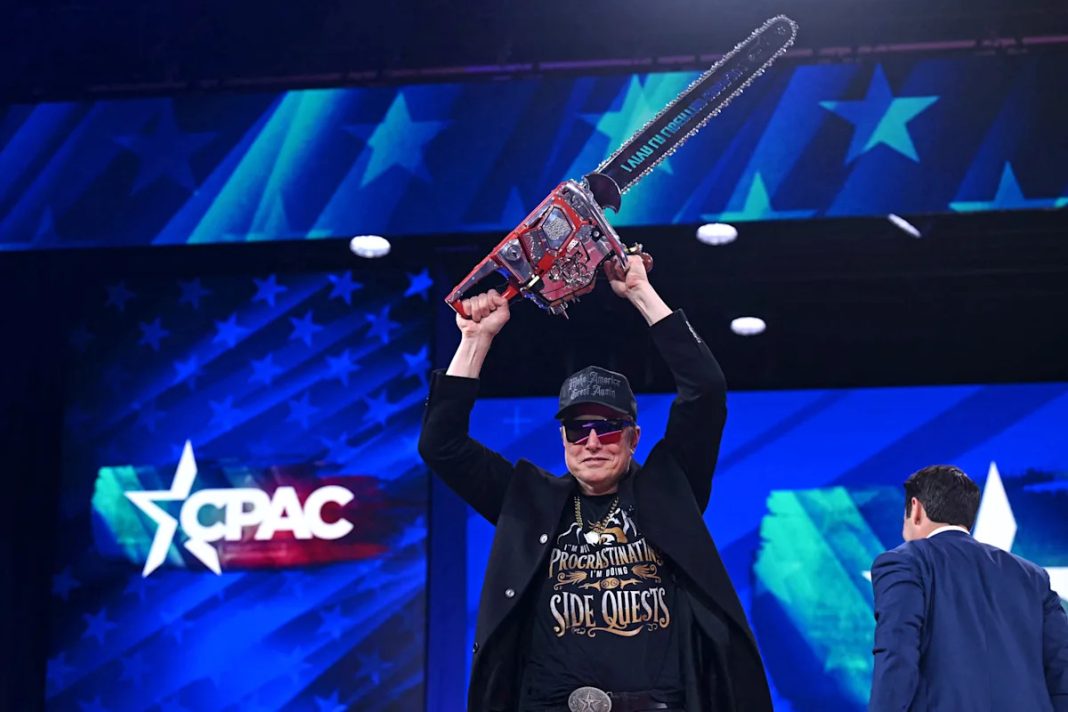In 1992, Ross Perot — a billionaire frustrated with America’s ballooning budget deficits and fed up with its two-party system — ran for president as an independent. He won 19% of the vote against the Republican incumbent (George H. W. Bush) and his Democratic challenger (Bill Clinton). A few years later, Perot formed a third party — the Reform Party — and ran again in 1996 as its first White House nominee.
Now Tesla CEO Elon Musk, another frustrated billionaire, seems to want to follow in Perot’s footsteps and build an even bigger, better third party of his own.
“When it comes to bankrupting our country with waste & graft, we live in a one-party system, not a democracy,” the world’s richest man wrote earlier this month on X, the social media platform he owns. “Today, the America Party is formed to give you back your freedom.”
Is Musk serious? And could his plan really work?
Why is Musk doing this?
It wasn’t so long ago that Musk was calling himself Trump’s “first buddy.” After spending more than $250 million to help his friend win the 2024 election, Musk spent the first few months of Trump’s second term waging a largely unchecked war against the federal bureaucracy as head of the newly formed Department of Government Efficiency (DOGE).
But then in early June the two tycoons had a major falling out over Trump’s “One Big, Beautiful Bill.”
Trump claims Musk was “upset” about “losing his EV mandate” — i.e., the $7,500 consumer tax credit that has long made buying or leasing electric vehicles such as Teslas more attractive and affordable for consumers. Musk insists he is concerned only with the legislation’s effect on federal spending — namely, initial estimates that showed it would “massively increase the already gigantic budget deficit [by] $2.5 trillion (!!!) and burden America[n] citizens with crushingly unsustainable debt,” as he wrote last month on X.
“I’m sorry, but I just can’t stand it anymore,” Musk continued. “This massive, outrageous, pork-filled Congressional spending bill is a disgusting abomination. Shame on those who voted for it: you know you did wrong. You know it.”
When a revised version of Trump’s bill passed the Senate earlier this month with an even heftier $3.3 trillion deficit projection, Musk unveiled his America Party scheme.
“Independence Day is the perfect time to ask if you want independence from the two-party (some would say uniparty) system!” he wrote on X. “Should we create the America Party?”
More than a million X users responded to Musk’s snap poll; 65% said yes; 35% said no.
“By a factor of 2 to 1, you want a new political party and you shall have it!” Musk vowed the following day.
What is Musk proposing?
Of course, there’s more to launching a third party than posting about it on social media. And so far, it appears that Musk hasn’t taken any of the steps required to get his America Party off the ground.
For one thing, Musk can’t officially start a new party until after 2028. Like Perot, a new, independent presidential candidate would first have to secure ballot access nationwide; in many states, they would actually have to compete in the 2028 election — and earn enough votes — to keep that ballot access. Then, and only then, could the so-called America Party petition the Federal Election Commission to become a real national political party — again, like Perot did with his Reform Party in 1995, three years after his initial presidential run.
In the meantime, Musk could file with the FEC to start an “America Party” political committee to assist his preferred candidates. In fact, some filings under that name did appear on the FEC website right after Musk’s X announcement; two even list Tesla CFO Vaibhav Taneja as treasurer and custodian of records. But according to Musk, those filings are bogus.
For now, the America Party seems short on substance. All we know is that Musk himself could never be its presidential candidate; he was born in South Africa, and the U.S. constitution requires the president to be “a natural born Citizen.” And, at least to start, the party might not even concern itself with the presidency.
“One way to execute on this would be to laser-focus on just 2 or 3 Senate seats and 8 to 10 House districts,” Musk hypothesized on July 4. “Given the razor-thin legislative margins, that would be enough to serve as the deciding vote on contentious laws, ensuring that they serve the true will of the people.”
Has anyone successfully started a third party before?
It depends how you define “successfully.” The Libertarian Party launched in 1971 and fielded its first presidential ticket the following year. By 1980, it had clinched ballot access in all 50 states. It remains America’s third-largest political party today.
Yet none of its recent presidential candidates have earned more than 3.3% of the national vote.
Meanwhile, the Reform Party slowly collapsed after the high-water mark of Perot’s 1996 campaign (8.4%). In 2000, it briefly flirted with Trump before nominating Pat Buchanan (0.4%). By the time Ralph Nader joined forces with the Reform Party four years later, it had lost its ballot line in all but seven states. Nader won just 0.38% of the vote.
The most successful third party, at least on the presidential level, was the Progressive (or “Bull Moose”) Party. In 1912, former Republican President Theodore Roosevelt broke with his protege and successor William Howard Taft and decided to run for a third term. Ultimately, Roosevelt earned 27% of the national vote — more than Taft (23%) and any other third-party candidate in U.S. history.
But note that it took a figure as familiar and well-credentialed as a former president to get that far — and even he didn’t win. Because Roosevelt and Taft divided the GOP, Democrat Woodrow Wilson wound up flipping the White House with just 42% of the vote.
“I think it’s ridiculous to start a third party,” Trump told reporters earlier this month. “The Democrats have lost their way, but it’s always been a two-party system, and I think starting a third party just adds to confusion.”
“Third parties have never worked, so he can have fun with it — but I think it’s ridiculous,” the president added.
Who really wants Musk’s America Party?
The idea of another option — something different from business as usual — is perennially popular. According to Gallup, a full 58% of Americans said last October that the United States needs a third party because Republicans and Democrats “do such a poor job” representing their interests. Over the past two decades, that number has averaged 56%; in 2023 it hit a record high of 63%.
Likewise, 43% of Americans told Gallup last year that they identify as independents rather than Democrats (28%) or Republicans (28%) — a number that has been rising for some time, especially among younger voters.
The problem is that the vast majority of self-described independents are actually just loyal Republicans or Democrats in disguise — and the few that remain generally seem unwilling to “waste their vote” by casting it for a non-Democrat or non-Republican.
Political data journalist G. Elliott Morris recently attempted to estimate the size of Musk’s potential coalition by taking the total U.S. voter pool and subtracting hardcore Republicans (24%), hardcore Democrats (32%), soft Republicans (22%) and soft Democrats (20%).
The America Party was left with less than 2% of the vote.
When Morris took a slightly different approach — removing (1) devoted partisans (67.5%); (2) any remaining pro-Trump voters (14%); (3) any remaining pro-spending voters (16%); and (4) any remaining anti-Musk voters (1.75%) — the America Party wound up with an even smaller slice of the electorate (0.75%).
Which isn’t to say that Musk has zero chance of “disrupting” America’s partisan status quo the way he’s already disrupted electric vehicles and space technology; no other third-party maestro has ever had his $400 billion fortune or his social-media megaphone.
Earlier this month, Nate Silver of the Silver Bulletin expressed skepticism about anchoring a new party to milquetoast “No Labels” centrism — but suggested Musk could find some long-term success by exploiting “blind spots in the major party agendas” on forward-facing issues such as AI and the fertility crisis.
“That’s what I’d be thinking about instead of just wanting to get revenge on Trump, or applying a template for third parties that has failed so often before,” Silver said.
In the meantime, perhaps Musk will start that political committee after all — and spend millions in the 2026 midterms lavishly funding challengers to MAGA lawmakers who backed Trump’s big, beautiful bill (while lambasting them on X).
If he does, he could potentially spoil the election for the GOP, according to a new poll by Echelon Insights, and head into the 2028 cycle with some third-party momentum.
“The way we’re going to crack the uniparty system is by using a variant of how Epaminondas shattered the myth of Spartan invincibility at Leuctra,” Musk predicted on X. “Extremely concentrated force at a precise location on the battlefield.”
Or he could simply go back to posting about other things on X and wait for everyone to forget about his latest big promise — as he has been known to do in the past.

